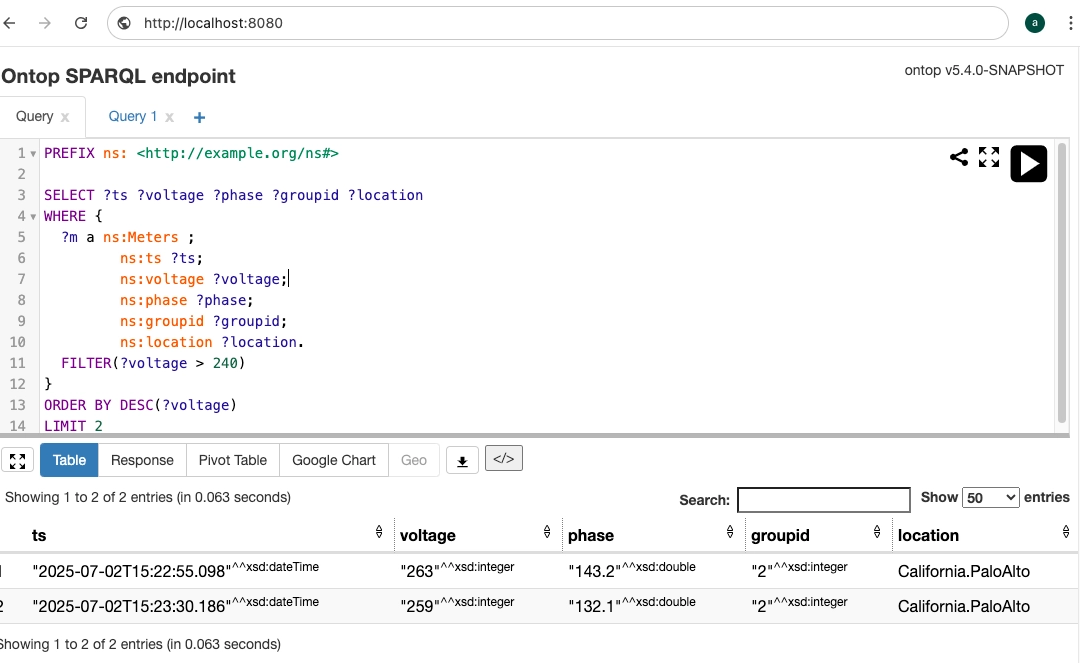Integrate with Ontop
Ontop is an open-source virtual knowledge graph system developed by the KRDB research group at the Free University of Bozen-Bolzano, Italy. It dynamically transforms relational database content into knowledge graphs without requiring data migration from original sources.
Data is queried through SPARQL (W3C-standardized RDF query language) interfaces and results are converted to RDF format.
Supports multiple databases including MySQL, PostgreSQL, Oracle, SQL Server, SQLite, and TDengine.
Prerequisites
Ontop connects to TDengine data sources via the TDengine Java Connector. Prepare the following environment:
- TDengine cluster version 3.3.6.0 or higher deployed and running (both Enterprise and Community editions supported).
- taosAdapter running normally, see taosAdapter Reference Manual for details.
- JDBC driver version 3.6.0 or higher, download.
- Ontop's TDengine support has been merged into the
version5branch but not yet released. Please download the source code and build according to the README.
Configure Data Source
Configuring TDengine data source in Ontop requires the following steps:
Install JDBC Driver
Download the JDBC DIST driver package (.jar file) and place it in the jdbc/ directory of the Ontop main program.
Configure JDBC Driver
Configure JDBC connection information in Ontop's .properties file:
jdbc.url = jdbc:TAOS-WS://[host]:[port]/[database]
jdbc.user = [username]
jdbc.password = [password]
jdbc.driver = com.taosdata.jdbc.ws.WebSocketDriver
For URL parameter details, refer to: TDengine URL Specification.
Configure Table Mapping
Define the mapping relationship between TDengine and Ontop in the .obda file (using smart meter scenario as example):
[PrefixDeclaration]
: http://example.org/tde
ns: http://example.org/ns#
[MappingDeclaration] @collection [[
mappingId meters-mapping
target ns:{ts} a ns:Meters ; ns:ts {ts} ; ns:voltage {voltage}; ns:phase {phase}; ns:groupid {groupid}; ns:location {location}^^xsd:string .
source SELECT ts, voltage, phase, groupid, location from test.meters
]]
Format Description
| Key Field | Description |
|---|---|
| mappingId | Mapping ID, uniquely identifies the mapping relationship |
| source | TDengine SQL query statement (supports complex queries) |
| target | Field mapping relationship (uses default conversion rules when type not specified) |
You can specify mapping data types in the target. If not specified, the following conversion rules apply:
| TDengine JDBC Data Type | Ontop Data Type |
|---|---|
| java.sql.Timestamp | xsd:datetime |
| java.lang.Boolean | xsd:boolean |
| java.lang.Byte | xsd:byte |
| java.lang.Short | xsd:short |
| java.lang.Integer | xsd:int |
| java.lang.Long | xsd:long |
| java.math.BigInteger | xsd:nonNegativeInteger |
| java.lang.Float | xsd:float |
| java.lang.Double | xsd:double |
| byte[] | xsd:base64Binary |
| java.lang.String | xsd:string |
| java.math.BigDecimal | xsd:decimal |
For complete .obda file format documentation, refer to Ontop OBDA Documentation.
Test Connection
Start the Ontop endpoint service to verify configuration:
ontop endpoint -p db.properties -m db.obda --port 8080
Access http://localhost:8080. If the SPARQL query interface appears, the configuration is successful.
Data Analysis
Scenario Introduction
Smart meter data from a residential community is stored in TDengine database. Using Ontop to transform TDengine smart meter data into a virtual knowledge graph, query devices with voltage exceeding 240V through SPARQL interface to identify high-load equipment.
Data Preparation
Generate simulation data using taosBenchmark:
# Generate 100 devices, 1000 records each
taosBenchmark -t 100 -n 1000 -y
Configuration Files
db.properties (connection configuration):
jdbc.url=jdbc:TAOS-WS://localhost:6041/test
jdbc.user=root
jdbc.password=taosdata
jdbc.driver=com.taosdata.jdbc.ws.WebSocketDriver
db.obda (mapping configuration):
Reuse the example content from the Configure Table Mapping section.
Analyze Meter Load
-
Create SPARQL query statement.
Query smart meter devices with voltage exceeding 240V, display top 2 results ordered by voltage descending:PREFIX ns: <http://example.org/ns#>
SELECT ?ts ?voltage ?phase ?groupid ?location
WHERE {
?m a ns:Meters ;
ns:ts ?ts;
ns:voltage ?voltage;
ns:phase ?phase;
ns:groupid ?groupid;
ns:location ?location.
FILTER(?voltage > 240)
}
ORDER BY DESC(?voltage)
LIMIT 2 -
Enter the above statement in the SPARQL query interface, click the "Run" button. Query results are shown below:

-
Results are returned in SPARQL JSON format, containing meter collection timestamps, voltage readings, phase, group ID, and device location information.
{
"head" : {
"vars" : [
"ts",
"voltage",
"phase",
"groupid",
"location"
]
},
"results" : {
"bindings" : [
{
"ts" : {
"datatype" : "http://www.w3.org/2001/XMLSchema#dateTime",
"type" : "literal",
"value" : "2025-07-02T15:22:55.098"
},
"voltage" : {
"datatype" : "http://www.w3.org/2001/XMLSchema#integer",
"type" : "literal",
"value" : "263"
},
"phase" : {
"datatype" : "http://www.w3.org/2001/XMLSchema#double",
"type" : "literal",
"value" : "143.2"
},
"groupid" : {
"datatype" : "http://www.w3.org/2001/XMLSchema#integer",
"type" : "literal",
"value" : "2"
},
"location" : {
"type" : "literal",
"value" : "California.PaloAlto"
}
},
{
"ts" : {
"datatype" : "http://www.w3.org/2001/XMLSchema#dateTime",
"type" : "literal",
"value" : "2025-07-02T15:23:30.186"
},
"voltage" : {
"datatype" : "http://www.w3.org/2001/XMLSchema#integer",
"type" : "literal",
"value" : "259"
},
"phase" : {
"datatype" : "http://www.w3.org/2001/XMLSchema#double",
"type" : "literal",
"value" : "132.1"
},
"groupid" : {
"datatype" : "http://www.w3.org/2001/XMLSchema#integer",
"type" : "literal",
"value" : "2"
},
"location" : {
"type" : "literal",
"value" : "California.PaloAlto"
}
}
]
}
}
Summary
Through TDengine and Ontop integration, this article demonstrates:
- Automatic conversion of time-series data to RDF, supporting SPARQL semantic queries.
- Unified data access interface compliant with W3C standards.
- Unlocking knowledge graph analysis and reasoning capabilities for industrial IoT.
This integration pioneers a new intelligent paradigm in the time-series database field. By combining the strong logical reasoning of knowledge graphs with the generalization capabilities of large language models, it provides intelligent analysis solutions with cognitive capabilities for complex IoT scenarios (such as device failure root cause analysis, energy efficiency optimization, etc.).